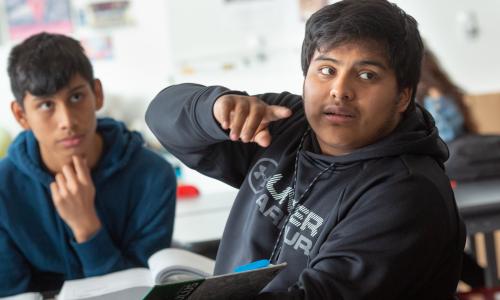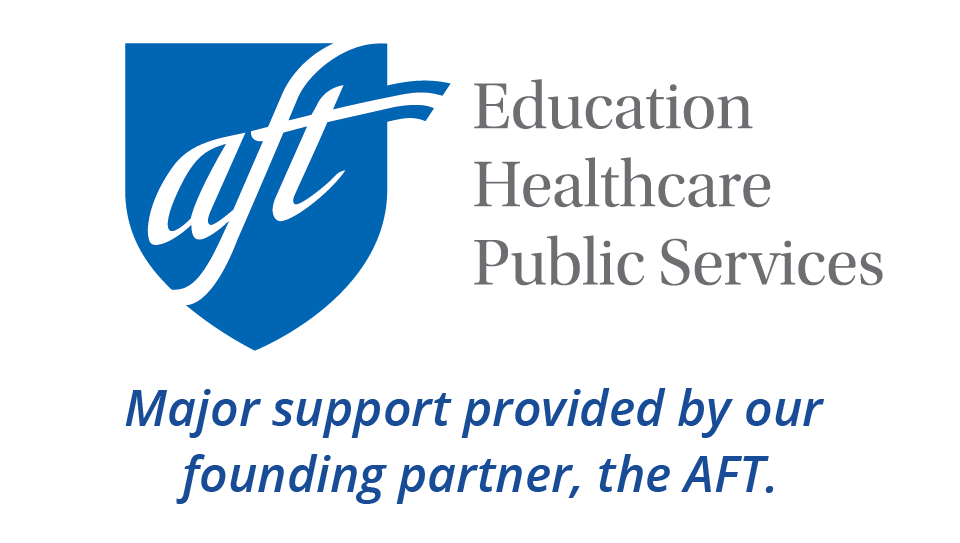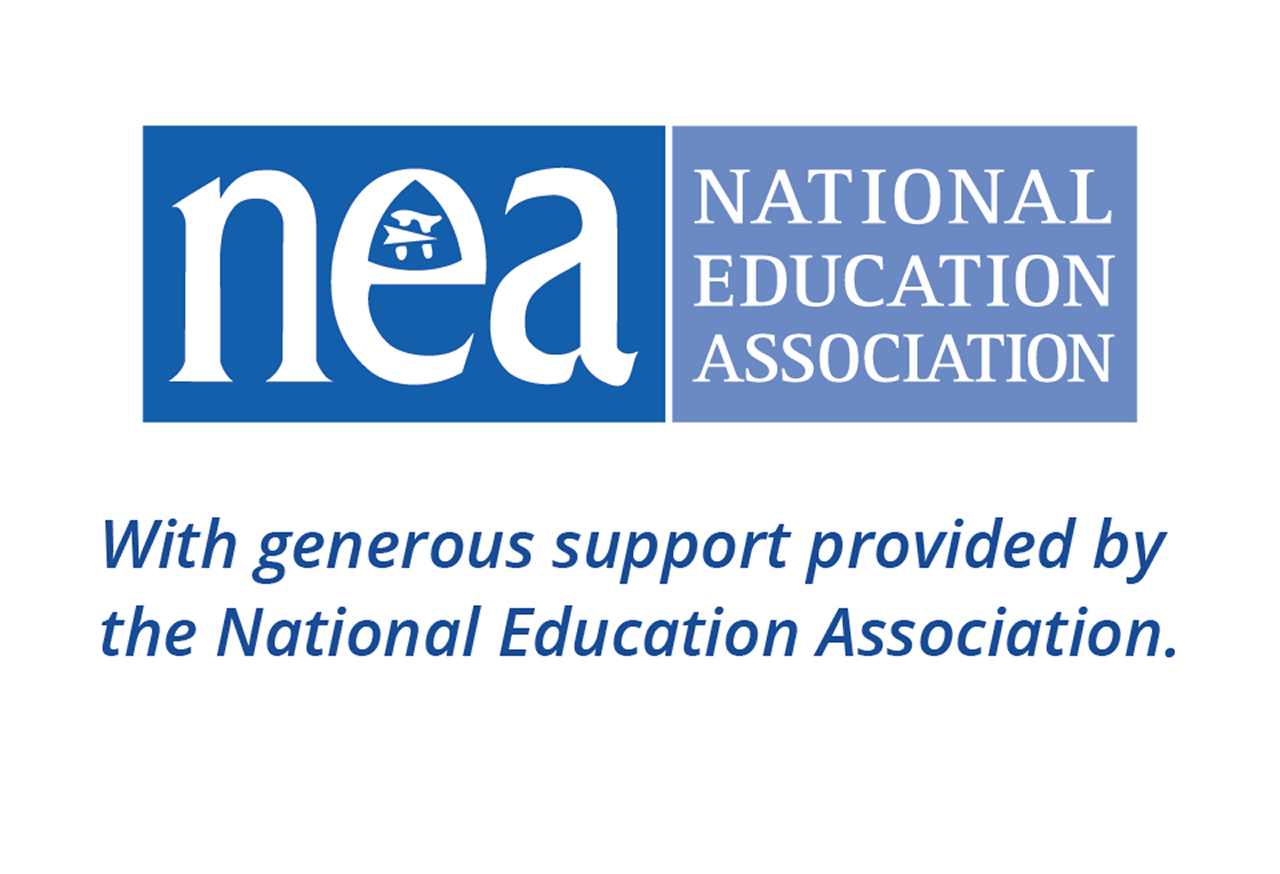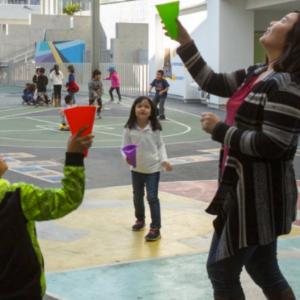 Beth Skelton and Tan Huynh have taught numerous experienced multilinguals, also known as Long-Term ELs (LTELs), during their long careers as ELL educators. In addition, Tan came to the U.S. as a refugee from Vietnam as a young child and faced many of the challenges that experienced multilinguals face in today's classrooms.
Beth Skelton and Tan Huynh have taught numerous experienced multilinguals, also known as Long-Term ELs (LTELs), during their long careers as ELL educators. In addition, Tan came to the U.S. as a refugee from Vietnam as a young child and faced many of the challenges that experienced multilinguals face in today's classrooms.
In this article written for Colorín Colorado, Beth and Tan share lessons they have learned from their students and personal experiences. You can see more in their related book, Long-Term Success for Experienced Multilinguals, which served as inspiration for many of the strategies they contributed to our ELL Strategy Library.
Students' Strengths
1. Our students have many strengths that often go unrecognized.
Experienced multilinguals (EMs) have been in an English-medium school for at least 5 years, so they bring cultural, linguistic, and experiential assets with them. Teachers can connect to these assets to enliven and enrich learning. For example, Tan was enrolled in ESL classes from Kindergarten to the end of 4th grade. By this time, Tan was involved in school activities such as choir, safety guards, and playing the flute. Outside of school, Tan was immersed in Vietnamese traditions, Buddhist practices, and work in the family trade. Tan's teachers could have bridged the curricular concepts with his experiences to make the learning more relevant, which would have opened pathways for him to contribute to the class more often.
2. Our students can achieve and excel — and want those opportunities.
Beth and her colleagues have interviewed many different experienced multilinguals about their educational experiences. When asked about their favorite classes, experienced multilinguals often choose classes in which they "learn a lot." These students generally express the desire to learn in high-challenge, high-support classes with their grade-level peers, rather than classes they perceive as basic or remedial. In these interviews with middle school experienced multilinguals, Beth was struck by how many chose math as their favorite subject, many of whom talked about how much they were learning. These students dismantle the narrative that they are lazy or unmotivated.
3. Our students benefit from high expectations.
Tan passed his public schooling years by charming his way through. Because he was highly motivated and fluent, this often masked his underdevelopment in academic English. Every time he submitted a project, he put in extra effort. For example, when he was expected to write a journal from the perspective of Lewis and Clark, he stained white paper with tea and coffee to make it look like parchment paper. He even burned the ends to make them look weathered. The journal received a 100, but that score was probably based on the presentation rather than the academic thinking and writing that were the intended goals. The perfect score made Tan think he had advanced academic skills; however, he later realized that the grade reflected more about the presentation than the content.
The problem that haunts experienced MLs like Tan is that passing scores, even the highest ones, may not be enough. When experienced MLs submit beautifully formatted work, we have to ask if it is meeting the highest academic expectations. When they respond to a question, we have to consider if they can use content-specific words and show coherent connections between their ideas. To transform the learning for experienced MLs, it's less about maintaining high expectations. It is about aligning our feedback to the clearly defined learning objectives.
Language and Literacy
4. Our students' social language may mask their academic language needs.
Experienced multilinguals can express their comprehension of complex concepts using their entire linguistic repertoire, which often includes other languages and basic interpersonal communication skills (BICS), also known as social language. For example, students may respond to a scientific question about the rate of photosynthesis in an experiment with the sentence, "There were more bubbles when the light was closer." When science teachers hear a response like this, they are often pleased that the students understood the concept and accept the response. However, to move along the continuum from spoken social language to written academic language, experienced multilinguals need support and clear guidance in how to express themselves with the precision of mathematicians, scientists, historians, artists, etc.
5. Our students benefit from the use of their heritage languages in the classroom.
One of the greatest assets experienced multilinguals have are their languages, not just English. When an experienced multilingual encounters an unfamiliar word in English, it is possible that this word already exists in their own languages. For example, when Tan's 10th grade student read a sentence about export and imports, the student was unfamiliar with it. However, when he looked up these words in Khmer, the student instantly grinned and said, "Oh, I know what these are in Khmer." Reading that article in English about exports and imports became instantly more accessible by having this student connect to his Khmer and his background knowledge. From this example, teachers can create a space for experienced MLs to use all of their linguistic assets to support and expand learning.
Independent Learning
6. Our students can benefit from learning how to use strategies independently.
ELL Strategy Library
See more strategies from Beth and Tan in our popular ELL Strategy Library!
This may be one of the most important lessons we have learned from our students. Zaretta Hammond calls learning strategies the "turbocharger" for learning.
Instead of just giving students an engineered task, we can explicitly teach them how to:
- chunk out the assignment
- write their own sentence starters by mirroring the prompts
- transfer their notes into more complex sentences and coherent texts
- start sentences with subordinating conjunctions (although, since, while, etc.)
- link one thought to the next with transition phrases (in addition, another reason, in contrast to, etc.).
For example, a Grade 10 English Language Arts teacher decided to spend an entire class period explicitly teaching her students, mostly experienced multilinguals, how to deconstruct and respond to a multi-part literary analysis prompt like this complex, multipart prompt:
Determine a theme in "The Tell-Tale Heart." Analyze how the characters, setting, and plot develop the theme you chose. Explain which element (character, setting, or plot) develops the theme most clearly.
She had engineered these types of prompts earlier in the year for the students. However, she knew that students would encounter multipart prompts like this on standardized assessments, and she wanted to explicitly teach students to independently deconstruct the prompt. First, she modeled the process, then she asked students work in teams to deconstruct a different prompt. Finally, the students tried to independently deconstruct a third prompt. After explicitly teaching students how to deconstruct each part of a complex, literary analysis prompt, experienced multilinguals and monolingual English speakers alike performed better on the exam. Instead of always giving students scaffolded assignments and assessments, we can explicitly teach them how to use effective learning strategies independently.
7. Our students know what kinds of scaffolds help them.
We have interviewed and talked to many students about the kinds of supports and scaffolds that help them the most in their classes. While they may not use educational lingo, most students can clearly articulate what types of scaffolds help them learn. During our interviews with experienced multilinguals, we asked: "What do teachers do that helps you learn?" and "What could teachers do to better support you?" Students explicitly mentioned the following scaffolds that were especially supportive to them: chunking instructions and assignments, labeling visuals, providing sentence starters, and creating opportunities for partner or small group work. If you wonder which scaffolds work for your students, ask them!
The Right Kind of Support
8. Our students need different kinds of support from newcomers.
Since experienced multilinguals have been in an English-medium school for at least 5 years, their language development needs are significantly different from students who are new to learning in English. Unlike students at beginning levels of language development, experienced multilinguals have developed social language skills; they can speak in complete, accurate sentences about their interests and their home life. They often seem quite fluent when chatting with their friends. They generally feel comfortable speaking English and they can usually switch fluently between English and their other languages depending on the context.
9. Our students may be overrepresented in special education classes.
Newcomer students spend their first phase of a new language acquiring social language. Many develop spoken proficiency quickly and are exited out of newcomer services. However, many seem to struggle to bridge the gap between social and academic language despite possibly more years of receiving English language development classes. Often, teachers want to hypothesize that there is another reason for their lack of progress. Unfortunately, many suggest that these experienced MLs have cognitive processing issues.
While some experienced multilingual learners do require special education services after being tested, for many others, their stalled progress can be addressed when they are provided with explicit, systematic, and structured academic language instruction. Since the structures in social and academic language are different, instruction that teaches MLs how to use academic vocabulary, sentence structure, and organization benefits their English language development. This type of instruction unveils the invisible language used by people in professional settings. By making this language more visible and explicitly teaching it to experienced MLs, we can address at least one challenge that may be contributing to some cases of over-identification for special education services.
About the Authors
 Tan Huynh is a career international school teacher, consultant, and author specializing in secondary multilinguals and teacher collaboration. Coming to America as a refugee at the age of 5, Tan vividly remembers the difficulties of acquiring a new language and integrating in American culture while nurturing his Asian roots. This experience is the main engine that drives his work today. At school, he spends most of his time collaborating with teachers and in content-area classes to make content accessible. The rest of the time is spent teaching English language and literacy skills. Outside of school, Tan often presents internationally to schools and districts to support their work with multilingual students. Tan also hosts a blog, online courses, and a podcast about teaching multilinguals. With whatever time is left, Tan likes to work out, play badminton, and get lost in nature with his dog child.
Tan Huynh is a career international school teacher, consultant, and author specializing in secondary multilinguals and teacher collaboration. Coming to America as a refugee at the age of 5, Tan vividly remembers the difficulties of acquiring a new language and integrating in American culture while nurturing his Asian roots. This experience is the main engine that drives his work today. At school, he spends most of his time collaborating with teachers and in content-area classes to make content accessible. The rest of the time is spent teaching English language and literacy skills. Outside of school, Tan often presents internationally to schools and districts to support their work with multilingual students. Tan also hosts a blog, online courses, and a podcast about teaching multilinguals. With whatever time is left, Tan likes to work out, play badminton, and get lost in nature with his dog child.
Beth Skelton is an independent consultant focused on creating equitable educational experiences for multilingual learners. She has been working in the field for over three decades teaching elementary, middle, high school and adult language learners in urban, suburban, rural, and international settings. As a university exchange student to Germany, Beth experienced firsthand the challenges that experienced multilinguals face when studying new content in their non-heritage language. She could communicate with peers, but still needed additional scaffolds to successfully write formal papers, read academic texts, and comprehend dense lectures. This influential experience still informs her work with students, teachers, schools, and districts around the world. Through workshops, coaching, and consulting, she advocates for all multilingual learners, especially those who have years of experience. Beth also enjoys hiking, skiing, yoga, playing marimba, gardening, and spending time with her family.








Add new comment